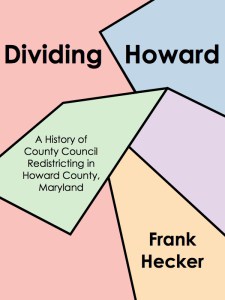For those of you who enjoyed my blog posts on Howard County Council redistricting so much that you’d like to read them all again in one convenient package, your wait is over: I’m proud to announce the publication of my new book Dividing Howard: A History of County Council Redistricting in Howard County, Maryland, now available for the Kindle from Amazon.com and for the Nook from Barnes and Noble.
 I’m selling the book for $2.99, and will donate all royalties I receive (about $2 per copy) to Voices for Children, the Court Appointed Special Advocate (CASA) program in Howard County. Voices for Children recruits and trains volunteer advocates to represent the best interests of abused and neglected children in the Howard County Courts. I’ll post updates from time to time on how many copies of the book I’ve sold and how much I’ve been able to donate.
I’m selling the book for $2.99, and will donate all royalties I receive (about $2 per copy) to Voices for Children, the Court Appointed Special Advocate (CASA) program in Howard County. Voices for Children recruits and trains volunteer advocates to represent the best interests of abused and neglected children in the Howard County Courts. I’ll post updates from time to time on how many copies of the book I’ve sold and how much I’ve been able to donate.
To answer some questions you may have:
You don’t actually need a Kindle or Nook device to read the book; you can use the Kindle or Nook applications for iPhone, iPad, and Android phones and tablets, available at no charge from the application stores for those devices. Don’t have a smartphone or tablet? You can use the Kindle or Nook applications for PC or Mac instead; just google “Kindle PC,” “Nook Mac,” and so on to find the application of your choice.
At this time I don’t have versions of the book available for download directly to the iBooks ereader application for iPhone or iPad or to ereader devices from Kobo, Sony, and others. That’s because those ereaders and their associated online stores don’t support an easy-t0-use no-charge self-publishing system like those provided by Amazon.com (Kindle Direct Publishing) and Barnes and Noble (PubIt!). However if your ereader device or application supports the EPUB ebook format and “sideloading” content then you can buy the Barnes and Noble version for the Nook application for PC or Mac, make a copy of the resulting EPUB-format file (which is DRM-free), and load it for use in your favorite ereader. (Ask your tech-y friends if you need more information on how to do this.)
At this time I have no plans to publish a print version of the book. Beyond the extra work involved, I’ve tried to take advantage of the ebook format and have included a lot of web links to primary sources. You can’t grep a dead tree, as the saying goes, and you can’t click on a link on one either. However if there’s a lot of people wanting this and I have copious spare time in the next month or two then I might reconsider.
Finally, the book ends where the blog series does, with the passage of the redistricting bill after the 2001 census (almost exactly ten years ago, as it happens). After the current round of redistricting ends I may produce a second edition that brings the story up to the present day, again depending on your interest and my time.
In the meantime buy the book, tell your friends, write a review or send me your suggestions on how to improve it. Thanks to all of you for reading the series over the past year and for providing the inspiration to collect it into book form.
P.S. A final note: There’s a minor glitch with the Kindle version of the book that causes the book to open to the last page the first time you read it after downloading. (Once you start reading it in the right place then the Kindle will remember where you were after that.) There may also be a few remaining typos I haven’t caught. At some point I may issue an updated version of the book and replace the current version on Amazon.com and Barnes and Noble. If and when I do that I’ll post instructions on how you can update your copy if you’d like to do that.
Angela Beltram - 2011-12-17 14:13
When the people voted to have districts, it was opposed by many people who realized that since the County Council sits as the Zoning Board, there was no way that four out of five could be held “accountable” for the actions of the majority. “Accountability” is the word people use who continue to support the Council as the Zoning board. There have been proposals to have a “Hearing Officer” who would be an “expert” in land use Maryland law and who would be much stricter that an elected Board who sometimes make “political” decisions on land use. There also has been some support for expanding the Council to 7 members with two running at large. That way, those two would have a “global” view of issues in the County and at the same time provide the citizens with a potential choice of voting for three ( a district represenative and two additional at large). I believe this will occur next time. For all the ballyhooing from the black community and the Republicans, they got what they wanted – districts. As stated by you and by me, personally at the hearings on the proposed idea of “districts” for School Board, I stated that C. Vernon Gray was elected over 25 years ago without “districts” and continued again to do so. So…I may not be around for the “next time” but you may remember these arguments.
hecker - 2011-12-17 22:23
Thanks for stopping by to comment! I very much appreciate hearing from people with first-hand knowledge of what went on.